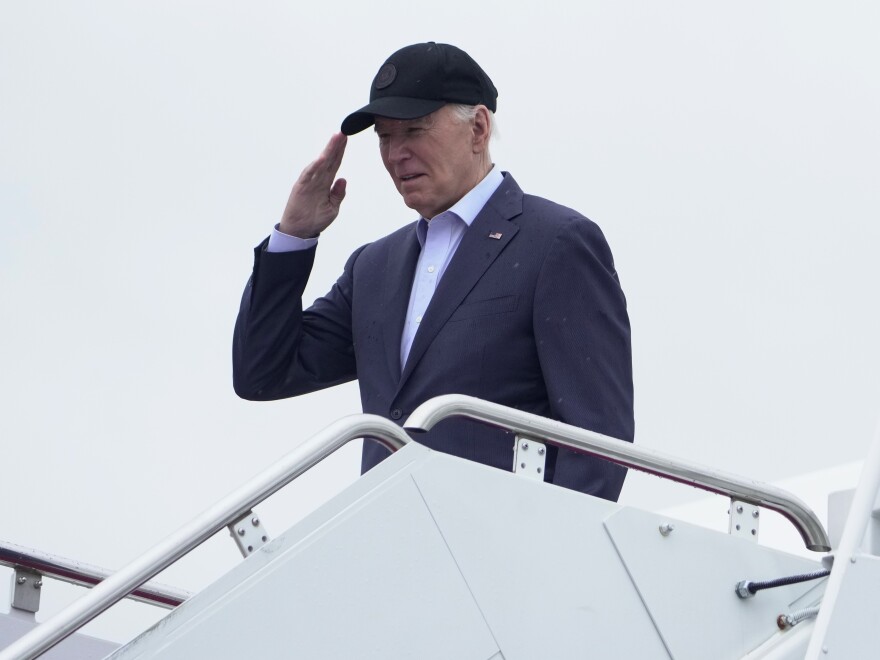Biden signs reauthorization of surveillance program into law despite privacy concerns
By The Associated Press
Published April 20, 2024

Manuel Balce Cenet AP
By The Associated Press
Published April 20, 2024

Manuel Balce Cenet AP
President Biden salutes as he boards Air Force One as he leaves Andrews Air Force Base, Md., on his way to his Delaware home on Friday.
April 20, 2024
WASHINGTON — President Biden on Saturday signed legislation reauthorizing a key U.S. surveillance law after divisions over whether the FBI should be restricted from using the program to search for Americans' data nearly forced the statute to lapse.
Barely missing its midnight deadline, the Senate had approved the bill by a 60-34 vote hours earlier with bipartisan support, extending for two years the program known as Section 702 of the Foreign Intelligence Surveillance Act. Biden thanked congressional leaders for their work.
"In the nick of time, we are reauthorizing FISA right before it expires at midnight," Senate Majority Leader Chuck Schumer said when voting on final passage began 15 minutes before the deadline. "All day long, we persisted and we persisted in trying to reach a breakthrough and in the end, we have succeeded."
U.S. officials have said the surveillance tool, first authorized in 2008 and renewed several times since then, is crucial in disrupting terrorist attacks, cyber intrusions, and foreign espionage and has also produced intelligence that the U.S. has relied on for specific operations, such as the 2022 killing of al-Qaida leader Ayman al-Zawahri.
"If you miss a key piece of intelligence, you may miss some event overseas or put troops in harm's way," Florida Sen. Marco Rubio, the top Republican on the Senate Intelligence Committee, said. "You may miss a plot to harm the country here, domestically, or somewhere else. So in this particular case, there's real-life implications."
The proposal would renew the program, which permits the U.S. government to collect without a warrant the communications of non-Americans located outside the country to gather foreign intelligence. The reauthorization faced a long and bumpy road to final passage Friday after months of clashes between privacy advocates and national security hawks pushed consideration of the legislation to the brink of expiration.
Though the spy program was technically set to expire at midnight, the Biden administration had said it expected its authority to collect intelligence to remain operational for at least another year, thanks to an opinion earlier this month from the Foreign Intelligence Surveillance Court, which receives surveillance applications.
Still, officials had said that court approval shouldn't be a substitute for congressional authorization, especially since communications companies could cease cooperation with the government if the program is allowed to lapse.
Hours before the law was set to expire, U.S. officials were already scrambling after two major U.S. communication providers said they would stop complying with orders through the surveillance program, according to a person familiar with the matter, who spoke on the condition of anonymity to discuss private negotiations.
Attorney General Merrick Garland praised the reauthorization and reiterated how "indispensable" the tool is to the Justice Department.
"This reauthorization of Section 702 gives the United States the authority to continue to collect foreign intelligence information about non-U.S. persons located outside the United States, while at the same time codifying important reforms the Justice Department has adopted to ensure the protection of Americans' privacy and civil liberties," Garland said in a statement Saturday.
But despite the Biden administration's urging and classified briefings to senators this week on the crucial role they say the spy program plays in protecting national security, a group of progressive and conservative lawmakers who were agitating for further changes had refused to accept the version of the bill the House sent over last week.

J. Scott Applewhite / AP
Senate Majority Leader Chuck Schumer, D-N.Y., looks over his notes during a meeting with Ukraine's Prime Minister Denys Shmyhal as Congress moves to advance an emergency foreign aid package for Israel, Ukraine and Taiwan, at the Capitol in Washington, Thursday, April 18, 2024.
The lawmakers had demanded that Schumer, D-N.Y., allow votes on amendments to the legislation that would seek to address what they see as civil liberty loopholes in the bill. In the end, Schumer was able to cut a deal that would allow critics to receive floor votes on their amendments in exchange for speeding up the process for passage.
The six amendments ultimately failed to garner the necessary support on the floor to be included in the final passage.
One of the major changes detractors had proposed centered around restricting the FBI's access to information about Americans through the program. Though the surveillance tool only targets non-Americans in other countries, it also collects communications of Americans when they are in contact with those targeted foreigners. Sen. Dick Durbin, the No. 2 Democrat in the chamber, had been pushing a proposal that would require U.S. officials to get a warrant before accessing American communications.
"If the government wants to spy on my private communications or the private communications of any American, they should be required to get approval from a judge, just as our Founding Fathers intended in writing the Constitution," Durbin said.
In the past year, U.S. officials have revealed a series of abuses and mistakes by FBI analysts in improperly querying the intelligence repository for information about Americans or others in the U.S., including a member of Congress and participants in the racial justice protests of 2020 and the Jan. 6, 2021, riot at the U.S. Capitol.
But members on both the House and Senate intelligence committees as well as the Justice Department warned requiring a warrant would severely handicap officials from quickly responding to imminent national security threats.
"I think that is a risk that we cannot afford to take with the vast array of challenges our nation faces around the world," said Sen. Mark Warner, D-Va. chairman of the Senate Intelligence Committee.
Copyright 2024 NPR. To see more, visit https://www.npr.org
April 20, 2024
WASHINGTON — President Biden on Saturday signed legislation reauthorizing a key U.S. surveillance law after divisions over whether the FBI should be restricted from using the program to search for Americans' data nearly forced the statute to lapse.
Barely missing its midnight deadline, the Senate had approved the bill by a 60-34 vote hours earlier with bipartisan support, extending for two years the program known as Section 702 of the Foreign Intelligence Surveillance Act. Biden thanked congressional leaders for their work.
"In the nick of time, we are reauthorizing FISA right before it expires at midnight," Senate Majority Leader Chuck Schumer said when voting on final passage began 15 minutes before the deadline. "All day long, we persisted and we persisted in trying to reach a breakthrough and in the end, we have succeeded."
U.S. officials have said the surveillance tool, first authorized in 2008 and renewed several times since then, is crucial in disrupting terrorist attacks, cyber intrusions, and foreign espionage and has also produced intelligence that the U.S. has relied on for specific operations, such as the 2022 killing of al-Qaida leader Ayman al-Zawahri.
"If you miss a key piece of intelligence, you may miss some event overseas or put troops in harm's way," Florida Sen. Marco Rubio, the top Republican on the Senate Intelligence Committee, said. "You may miss a plot to harm the country here, domestically, or somewhere else. So in this particular case, there's real-life implications."
The proposal would renew the program, which permits the U.S. government to collect without a warrant the communications of non-Americans located outside the country to gather foreign intelligence. The reauthorization faced a long and bumpy road to final passage Friday after months of clashes between privacy advocates and national security hawks pushed consideration of the legislation to the brink of expiration.
Though the spy program was technically set to expire at midnight, the Biden administration had said it expected its authority to collect intelligence to remain operational for at least another year, thanks to an opinion earlier this month from the Foreign Intelligence Surveillance Court, which receives surveillance applications.
Still, officials had said that court approval shouldn't be a substitute for congressional authorization, especially since communications companies could cease cooperation with the government if the program is allowed to lapse.
Hours before the law was set to expire, U.S. officials were already scrambling after two major U.S. communication providers said they would stop complying with orders through the surveillance program, according to a person familiar with the matter, who spoke on the condition of anonymity to discuss private negotiations.
Attorney General Merrick Garland praised the reauthorization and reiterated how "indispensable" the tool is to the Justice Department.
"This reauthorization of Section 702 gives the United States the authority to continue to collect foreign intelligence information about non-U.S. persons located outside the United States, while at the same time codifying important reforms the Justice Department has adopted to ensure the protection of Americans' privacy and civil liberties," Garland said in a statement Saturday.
But despite the Biden administration's urging and classified briefings to senators this week on the crucial role they say the spy program plays in protecting national security, a group of progressive and conservative lawmakers who were agitating for further changes had refused to accept the version of the bill the House sent over last week.

J. Scott Applewhite / AP
Senate Majority Leader Chuck Schumer, D-N.Y., looks over his notes during a meeting with Ukraine's Prime Minister Denys Shmyhal as Congress moves to advance an emergency foreign aid package for Israel, Ukraine and Taiwan, at the Capitol in Washington, Thursday, April 18, 2024.
The lawmakers had demanded that Schumer, D-N.Y., allow votes on amendments to the legislation that would seek to address what they see as civil liberty loopholes in the bill. In the end, Schumer was able to cut a deal that would allow critics to receive floor votes on their amendments in exchange for speeding up the process for passage.
The six amendments ultimately failed to garner the necessary support on the floor to be included in the final passage.
One of the major changes detractors had proposed centered around restricting the FBI's access to information about Americans through the program. Though the surveillance tool only targets non-Americans in other countries, it also collects communications of Americans when they are in contact with those targeted foreigners. Sen. Dick Durbin, the No. 2 Democrat in the chamber, had been pushing a proposal that would require U.S. officials to get a warrant before accessing American communications.
"If the government wants to spy on my private communications or the private communications of any American, they should be required to get approval from a judge, just as our Founding Fathers intended in writing the Constitution," Durbin said.
In the past year, U.S. officials have revealed a series of abuses and mistakes by FBI analysts in improperly querying the intelligence repository for information about Americans or others in the U.S., including a member of Congress and participants in the racial justice protests of 2020 and the Jan. 6, 2021, riot at the U.S. Capitol.
But members on both the House and Senate intelligence committees as well as the Justice Department warned requiring a warrant would severely handicap officials from quickly responding to imminent national security threats.
"I think that is a risk that we cannot afford to take with the vast array of challenges our nation faces around the world," said Sen. Mark Warner, D-Va. chairman of the Senate Intelligence Committee.
Copyright 2024 NPR. To see more, visit https://www.npr.org
SURVEILLANCE LAW, SIGNED BY BIDEN STIRRING PRIVACY AND SECURITY DEBATES
By Emman Omwanda
April 22, 2024

CONTENTS
1. New surveillance law, Privacy, and Security Concerns
2. Impacts of the Law on Internet Service Providers
New law boosts surveillance and ignites privacy debates.
Bipartisan support is evident despite concerns about civil liberties.
Amendment for warrant requirements narrowly defeated in House.
President Joe Biden enacted the continuation and amendment of Section 702 of the Foreign Intelligence Surveillance Act (FISA), up to the addition of two years to American surveillance practice. While true supporters described the legislation as good in the hour of need, there were quite a few challengers to it, even from the group of privacy advocates and some of the politicians who believed it could go against Americans’ basic rights.
New surveillance law, Privacy, and Security Concerns
The bill, Reforming Intelligence and Securing America Act, has received overwhelming support from bipartisan representatives, Sullivan added as a National Security Adviser. It is hoped that it will provide a further constitutional check on the use of Section 702 to prevent national security risks.
Such an inheritance gives rise to all intelligence and law enforcement agencies, such as the NSA, the FBI, and the CIA, being able to examine foreign communications without a warrant, which some suppose could eventually lead to direct surveillance of U.S. citizens. Thus, this raises the concern of privacy and security.
A distinct divide between the two prominent factors of national security and personal privacy rights was well-illustrated by a legislative process. Although the bill drew widely spread backing mainly because it served as a means to fight terrorism and protect national security, opponents claimed that the bill had the possibility of abusing the powers of surveillance activities. The most notable among the critics was Elizabeth Goitein from the Brennan Center for Justice, who found the bill’s nominal reform inadequate for defending civil rights.
Impacts of the Law on Internet Service Providers
The bill passed the House; nonetheless, it generated dispute; an amendment that asked security agencies to obtain a warrant for internet-based surveillance occasionally failed in the House. This move was a visible reflection of the ever-growing challenges that must be overcome to achieve the right balance between the need for safety and privacy.
As the implications of Internet service providers and privacy regulations continue to evolve, the need for robust surveillance policies and rigorous implementation of these safeguards becomes increasingly prominent. Under Section 702 renewal, the U.S. intelligence agencies may also demand providers like Google or Verizon to display internet users’ data for investigative purposes, thus expanding data collection techniques from their national criteria.
This capability raises concerns for consumer rights activists, who fear that the new law would require many internet service providers whose duties are unclear to pivot to government spying.
For this reason, the White House says that this very specific act, the Reforming Intelligence and Securing America Act, has included the smartest and most powerful set of changes concerning oversight, privacy, and civil liberties. These initiatives are designed to balance the rising demand for intelligence with the desire to respect individual privacy rights.
After the law is implemented, discussions on the right balance between national security and privacy will continue, raising several areas of concern like policy, governance, and citizen rights. This continuing dialogue is highly likely to impact the making of laws and, as a result, judicial decisions related to privacy in the United States.
Disclaimer. The information provided is not trading advice. Cryptopolitan.com holds no liability for any investments made based on the information provided on this page. We strongly recommend independent research and/or consultation with a qualified professional before making any investment decision.

Emman Omwanda is a blockchain reporter who dives deep into industry news, on-chain analysis, non-fungible tokens (NFTs), Artificial Intelligence (AI), and more. His expertise lies in cryptocurrency markets, spanning both fundamental and technical analysis.
By Emman Omwanda
April 22, 2024

CONTENTS
1. New surveillance law, Privacy, and Security Concerns
2. Impacts of the Law on Internet Service Providers
New law boosts surveillance and ignites privacy debates.
Bipartisan support is evident despite concerns about civil liberties.
Amendment for warrant requirements narrowly defeated in House.
President Joe Biden enacted the continuation and amendment of Section 702 of the Foreign Intelligence Surveillance Act (FISA), up to the addition of two years to American surveillance practice. While true supporters described the legislation as good in the hour of need, there were quite a few challengers to it, even from the group of privacy advocates and some of the politicians who believed it could go against Americans’ basic rights.
New surveillance law, Privacy, and Security Concerns
The bill, Reforming Intelligence and Securing America Act, has received overwhelming support from bipartisan representatives, Sullivan added as a National Security Adviser. It is hoped that it will provide a further constitutional check on the use of Section 702 to prevent national security risks.
Such an inheritance gives rise to all intelligence and law enforcement agencies, such as the NSA, the FBI, and the CIA, being able to examine foreign communications without a warrant, which some suppose could eventually lead to direct surveillance of U.S. citizens. Thus, this raises the concern of privacy and security.
A distinct divide between the two prominent factors of national security and personal privacy rights was well-illustrated by a legislative process. Although the bill drew widely spread backing mainly because it served as a means to fight terrorism and protect national security, opponents claimed that the bill had the possibility of abusing the powers of surveillance activities. The most notable among the critics was Elizabeth Goitein from the Brennan Center for Justice, who found the bill’s nominal reform inadequate for defending civil rights.
Impacts of the Law on Internet Service Providers
The bill passed the House; nonetheless, it generated dispute; an amendment that asked security agencies to obtain a warrant for internet-based surveillance occasionally failed in the House. This move was a visible reflection of the ever-growing challenges that must be overcome to achieve the right balance between the need for safety and privacy.
As the implications of Internet service providers and privacy regulations continue to evolve, the need for robust surveillance policies and rigorous implementation of these safeguards becomes increasingly prominent. Under Section 702 renewal, the U.S. intelligence agencies may also demand providers like Google or Verizon to display internet users’ data for investigative purposes, thus expanding data collection techniques from their national criteria.
This capability raises concerns for consumer rights activists, who fear that the new law would require many internet service providers whose duties are unclear to pivot to government spying.
For this reason, the White House says that this very specific act, the Reforming Intelligence and Securing America Act, has included the smartest and most powerful set of changes concerning oversight, privacy, and civil liberties. These initiatives are designed to balance the rising demand for intelligence with the desire to respect individual privacy rights.
After the law is implemented, discussions on the right balance between national security and privacy will continue, raising several areas of concern like policy, governance, and citizen rights. This continuing dialogue is highly likely to impact the making of laws and, as a result, judicial decisions related to privacy in the United States.
Disclaimer. The information provided is not trading advice. Cryptopolitan.com holds no liability for any investments made based on the information provided on this page. We strongly recommend independent research and/or consultation with a qualified professional before making any investment decision.

Emman Omwanda is a blockchain reporter who dives deep into industry news, on-chain analysis, non-fungible tokens (NFTs), Artificial Intelligence (AI), and more. His expertise lies in cryptocurrency markets, spanning both fundamental and technical analysis.












